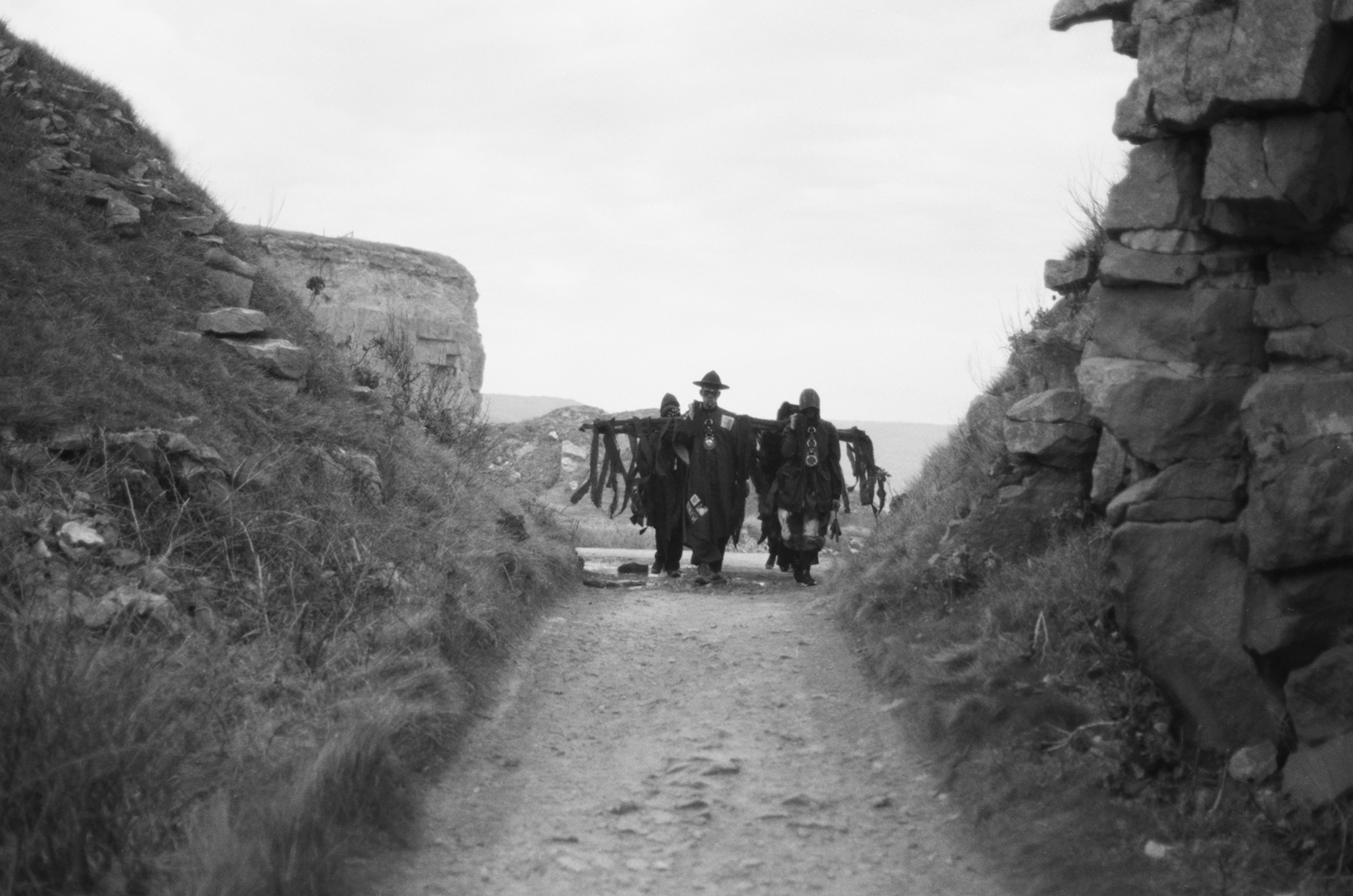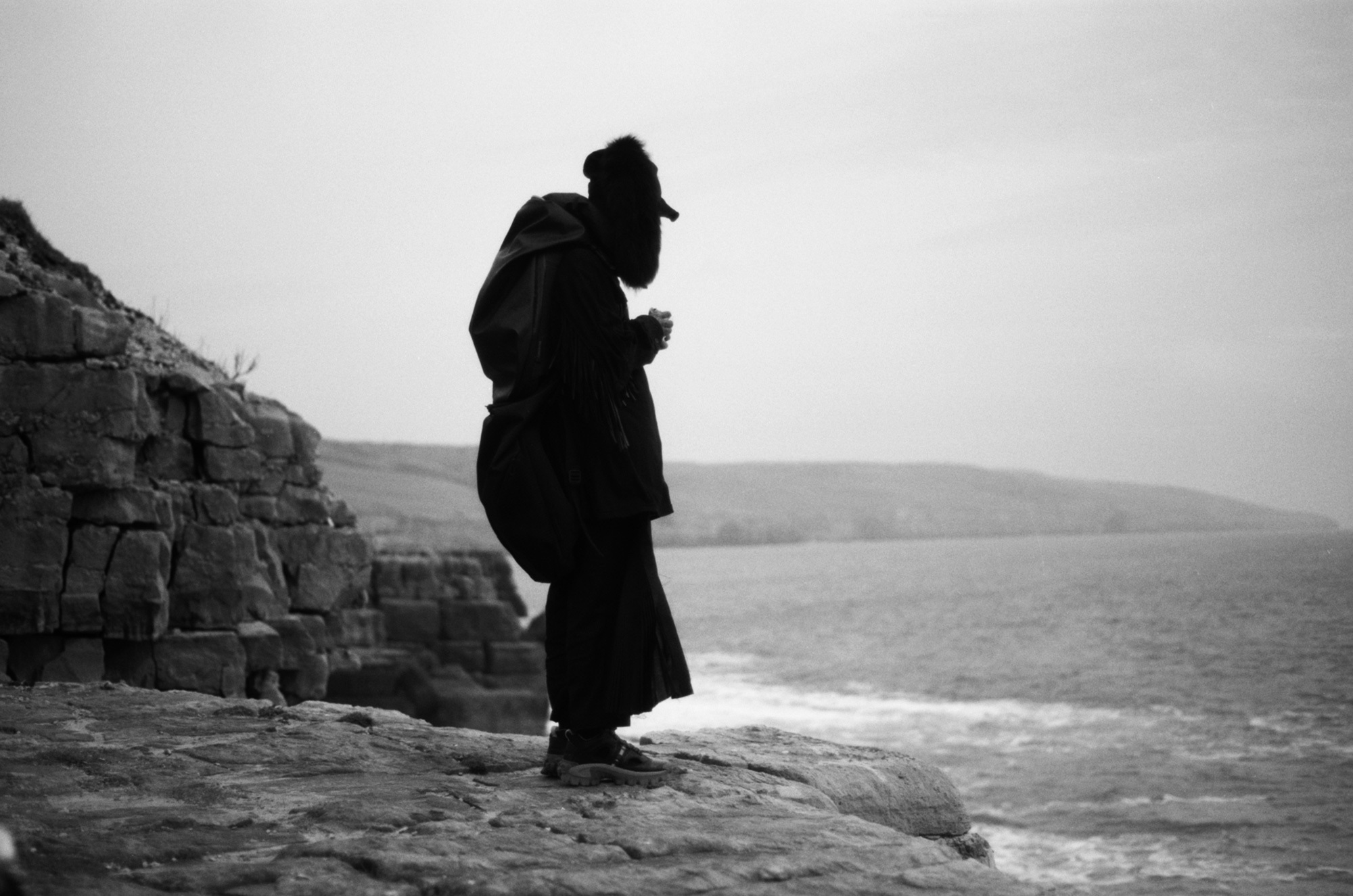Back in 2014, filmmaker Chris Read and his friend the photographer James Pearson-Howes were commissioned by the Tate to produce a film documenting contemporary folklore for its 2014 British Folk Art show. The pair’s hallucinogenic short drew footage from up and down the country, proving that local folk practices – from processional play hunts to the ceremonial torching of effigies – were anarchically, surreally alive in England. Their latest project Silence is Broken, felt like a natural continuation, taking modern folk a step further into fictitious future rituals.
Silence is Broken opens and closes with shots of primordial rugged coastline. Wind rushes through grass, Atlantic tides recede, and a procession of young men of mixed races in black garb, their faces smeared with black paint, carry a wooden structure on their shoulders to the hypnotic incantations of one of grime’s revered outsiders, Trim. Descending a grass hill to a sea cave, the structure is ceremoniously lit, throwing flames and shadows against the walls, as the boys step and sway to Trim’s emphatic vocals, reaching an incandescent climax.
“Folk events can be perceived as oldy and not very youthful,” says James who was pivotal in bringing folk out of the shadows with his 2014 book British Folk Trilogy. The book, as cultural stimuli, had a direct impact on a whole cohort of young creatives including Liam Hodges.
“It’s re-appropriation,” Chris continues. “From the clothing, to the music, to the design of the effigy. It’s about taking reference points and then giving the team of creatives and artists we worked with the space to bring something new and original to our film.”
The most basic common elements of the festivals captured for Tate were procession, lyrical storytelling and song, so music became a natural bridge. Chris and James found themselves asking who performed the same role of the folk musician in modern music today… They approached Trim.
As one of the genre’s originators, Trim not only has years on his side, but also the disposition to merge eclectic references and obscurely mythologise. And you couldn’t get a more local style than grime, which was born from just a few East London boroughs. “I’d shot loads of grime when it first came out,” says James. “We knew Trim, being lyrically versatile and a very smart guy, could develop the concept.” To a solemn soundtrack composed by producer and musician Bell Towers, Trim’s lyric picks up on solidarity and the power in being heard: “They will think of us when only the smoke clears and the truth is spoken/ Because united we stand, divided we’re hopeless. Another silence is broken.”

Misconceptions that history belongs to anyone in particular and that these practices are fixed still stalk folklore in England. As culture plays out, traditions are evolving. Some like blacking up feel sinister today, but as an outsider art practice much of their original symbolism came from fertility rites, the passing of seasons and mystical beliefs that have been lost or obscured. Fragments from medieval records of a group of blacked-up woodland people in Kent reported that they were servants of forest spirits.
For the most part, folklore is barbed with rebellious, anti-government and anti-capitalist attitudes. In Henry VII’s era, having a painted face in the countryside was considered a felony because it was the poacher’s first defence against identification by the authorities. A later tradition, from the nineteenth century, which formed the basis for this project were luddite songs. Cropper Lads were skilled workers in the pre-industrial cotton mills whose professions disappeared with the arrival of machinery. Alienated and disenfranchised, they set about destroying the machines.

England’s weirdness and future folklore is there for the taking. “Threatened by change, England’s multifaceted society can feel divided, which is why uniting people from disparate backgrounds and continually creating new narratives and traditions towards a shared future is so crucial,” explains Chris.
Though that’s not to say that just cutting loose isn’t a large part of it. “The majority of these festivals are an excuse to get pissed up,” says James, “But we didn’t want to bring in some futuristic stella.”
On the eve of an election to decide whether our isles will leave or remain a part of the EU, more than ever, Trim’s lyric resonates – “United we stand, Divided we’re hopeless.”

chrisread.tv
jamespearsonhowes.com
Credits
Photography James Pearson-Howes and Luke Farly
